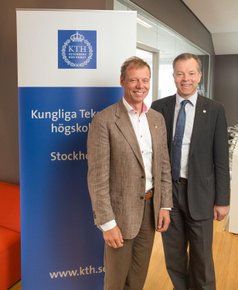Astronaut’s radiation study will be critical for Mars mission
Human Spaceflight
As space exploration inches closer to Mars, research into space radiation will become increasingly critical, says ESA astronaut Christer Fuglesang, who was introduced yesterday as the new head of the Aerospace Engineering master’s programme at KTH Royal Institute of Technology.

Greeting the media and answering questions at KTH’s Stockholm campus, Sweden’s first astronaut outlined his research agenda at the university and explained how he will serve as an ambassador for space science and exploration, splitting his time between KTH and the Swedish National Space Board.
In addition to research on particle physics, the 56-year-old adjunct professor will continue the “critical” work that he has done at ESA in the subject of space radiation. “We need to know how much radiation people will be exposed to when they go to Mars,” Fuglesang says. “In order to determine that, you need to know how much radiation there is in space – using detectors to measure – and how the radiation itself changes from the outside of the spaceship to the interior.”
Fuglesang says the research will lead to design work in materials and the use of magnetic fields that could protect astronauts from radiation. “Magnetic fields can to some extent repel radiation. Or if you have good materials you can absorb some of it. But that is very difficult because these high-energy particles can penetrate through a lot of material, and it is expensive to send material mass up into space.”

While he remains an ESA astronaut, Fuglesang will stay on the ground for the foreseeable future. Nevertheless, he is excited about the near future of space travel, which he says will include revisiting the moon and an expansion in commercial exploration.
Fuglesang says that the road to Mars will in all likelihood lead humans once again to the surface of the moon, where more practical knowledge about space operations can be gained before venturing farther into space. The moon offers a relatively close-to-home proving ground for techniques that would make Mars exploration possible, such as using local resources to generate energy and supply astronauts with oxygen and water, he says.
“The more we can learn to use the resources that are in any (celestial) body we go to, the less we need to bring there,” he says.
Private space travel is another development to watch, Fuglesang says. “There are some interesting developments in these private companies, who have some financial support from NASA, but a lot of their own money and risk being put into developing human space vehicles,” he says. “This is a new trend that will change human space flight.”
Tourism and research could be possibilities for private spaceflight, he says. But these operations will likely remain in Earth’s lower orbit and the government-funded space programs will focus “on the front line – which in my opinion should be back to the moon and eventually to Mars,” he says.
In addition to his research, Fuglesang will develop and teach a new course, “Human Spaceflight,” which examines issues around manned space flight, spacecraft design, current field research and the future of space travel.
The Stockholm native entered the history books as the first Swedish citizen in space on December 10, 2006, while serving as mission specialist on a flight to the International Space Station aboard the Space Shuttle Discovery. He boarded Discovery once again in 2008 to return to the Space Station. Fuglesang made a total of five spacewalks with NASA.
A member of the European Astronaut Corps since 1992, Fuglesang served as prime Crew Interface Coordinator (CIC) on the Euromir 95 mission in 1996, as part of an ESA-Russian collaboration on the Mir space station. Fuglesang earned his master’s degree in Engineering Physics at KTH. He has a doctorate in experimental particle physics from Stockholm University (1987), and was appointed associate professor (docent) of particle physics at Stockholm University in 1991. Since 2010, he had served as Head of Science and Application Division within the Directorate of Human Spaceflight and Operations at ESTEC, Netherlands.
David Callahan

